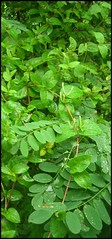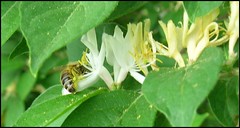Strangers in a Strange Land
 When I was working on my Master's degree, I took a class called Plant Taxonomy. The "lab" for plant tax involved everyone driving to a spot somewhere in Cabell County -- almost always a different place each time -- and following Dr. Evans around as he pointed out plants. We would all then collect a sample of the plant, press it, and have it as a reference for study for the exam. One of his rules was that in order to take a sample from the tree -- plant -- vine -- whichever it was, we had to snip it using a cutting tool instead of ripping it off. This was so we wouldn't harm the plant. The one exception to this rule was honeysuckle vine. Dr. Evans hated honeysuckle, and he didn't care if we wreaked havoc on the vine.
When I was working on my Master's degree, I took a class called Plant Taxonomy. The "lab" for plant tax involved everyone driving to a spot somewhere in Cabell County -- almost always a different place each time -- and following Dr. Evans around as he pointed out plants. We would all then collect a sample of the plant, press it, and have it as a reference for study for the exam. One of his rules was that in order to take a sample from the tree -- plant -- vine -- whichever it was, we had to snip it using a cutting tool instead of ripping it off. This was so we wouldn't harm the plant. The one exception to this rule was honeysuckle vine. Dr. Evans hated honeysuckle, and he didn't care if we wreaked havoc on the vine.Honeysuckle vine -- or at least the one that earned the despise of Dr. Evans -- is Lonicera japonica. It is a vine, not a bush, and the leaves on the end of each branch are separate, not round (in case you ever have to pass a plant tax exam). The first picture in this post is of L. japonica. See the red stem running from top to bottom? That's the vine. The only other plant in the picture is a branch of a locust tree (in the foreground) and the honeysuckle is trying to kill it.
This plant was introduced to the United States in 1806; it originally came from Japan and China. It is an interloper. According to an article on a web site called "Hilton Pond:"
If azaleas and magnolias are the country club elites of the plant world, honeysuckle is the low-rent trash. It lives anywhere it lands, and multiplies like rabbits on Viagra....My backyard crop responds best after I've run over it with my car or backed into it with my lawn mower. I even stack plywood on it and still it comes back bigger and bushier than ever. Try doing that with your heirloom roses.
 Bill Hilton Jr., a biologist, says, "It's great for the birds and bees but it doesn't belong here." While it may not "belong here," it has adapted so well to our area that it flourishes. It blocks the sun from trying to reach other plants, and it is a strangler, growing so well that "it encircles other plants and young trees, literally choking the life out of it."
Bill Hilton Jr., a biologist, says, "It's great for the birds and bees but it doesn't belong here." While it may not "belong here," it has adapted so well to our area that it flourishes. It blocks the sun from trying to reach other plants, and it is a strangler, growing so well that "it encircles other plants and young trees, literally choking the life out of it."Think back to yesterday's post about my conversation with the older lady in about anger. Before the conversation was finished, she said, "We all sin. We are made to sin."
I can't argue with the first part of that statement. We do all sin. Were we made to sin? I think the answer to that is a resounding NO. We were not created to sin. We are like the japanese honeysuckle vine -- we are strangers in a strange land. We are meant to be -- we were created to be -- like Adam and Eve were. We are created to be in communion with God, and yet we find ourselves here, separated from God. God reaches across the chasm to us, and sometimes we try to reach back, and sometimes He actually touches us, but this is not our home country.
How do we react and adapt to being in a foreign land? Do we act like the honeysuckle vine, choking and strangling each other, blocking out the light of the son? Or do we run and hide, too afraid to venture out at all?
God has given us each other. He has told us that we are to love him and to love one another. How do we adapt to this foreign land? I think that "greatest commandment" is the answer.
 Images: The first one was taken up at the end of our street (in the rain -- see what lengths I go to?) It is definitely (I think) Lonicera japonica. The other two photos are of honeysuckle, but I think that they are bushes, and are not the Japanese variety, but they are pretty, and look, I took a picture of a bee.
Images: The first one was taken up at the end of our street (in the rain -- see what lengths I go to?) It is definitely (I think) Lonicera japonica. The other two photos are of honeysuckle, but I think that they are bushes, and are not the Japanese variety, but they are pretty, and look, I took a picture of a bee.

0 Comments:
Post a Comment
<< Home